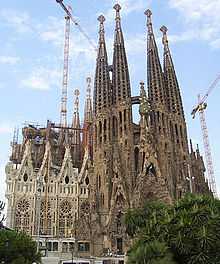Llotja
From Wikipedia, the free encyclopedia
- For the school, see Escola de la Llotja.
Llotja (Eastern Catalan: [ˈʎɔdʒə], Western Catalan: [ˈʎɔdʒa]; Aragonese: Loncha; Spanish: Lonja) is a Catalan/Valencian term used to define buildings that, during the Middle Ages, were used for commercial transactions.
Others, in feudal towns, were used for fishing and livestock market.
Llotjas of the former Crown of Aragon
The existing Llotjas of the former Crown of Aragon are:
- Llotja of Valencia or Llotja de la Seda, civil Gothic monument built between 1482 and 1492, by the mason master Pere Compte. It was declared a World Heritage Site by UNESCO on December 7, 1996.
- Llotja of Palma or Sa Llotja, (1420-1452).
- Llotja of Barcelona or Llotja del Mar, (1352-1453) (reformed 1774-1802).
- Llotja of Perpignan (14th-16th centuries).
- Llotja del Cànem in Castellón de la Plana.
- Llotja of Castelló d'Empúries (c. 1393).
- Llotja of Tortosa (1368-1373).
- Loncha of Alcañiz (15th century).
Llotjas built after Spanish unification
The Llotjas built after Spanish unification are:
- Loncha of Zaragoza (1541-1551).
- La Porxada de Granollers (1586-1587).
- Casa Lonja de Sevilla, in which centralized all trade of America with Spain from 1580 to 1717, including all types of products.
- Antigua Lonja (18th century) in El Puerto de Santa María.
| |||||||||||||||||
This article is issued from Wikipedia. The text is available under the Creative Commons Attribution/Share Alike; additional terms may apply for the media files.
